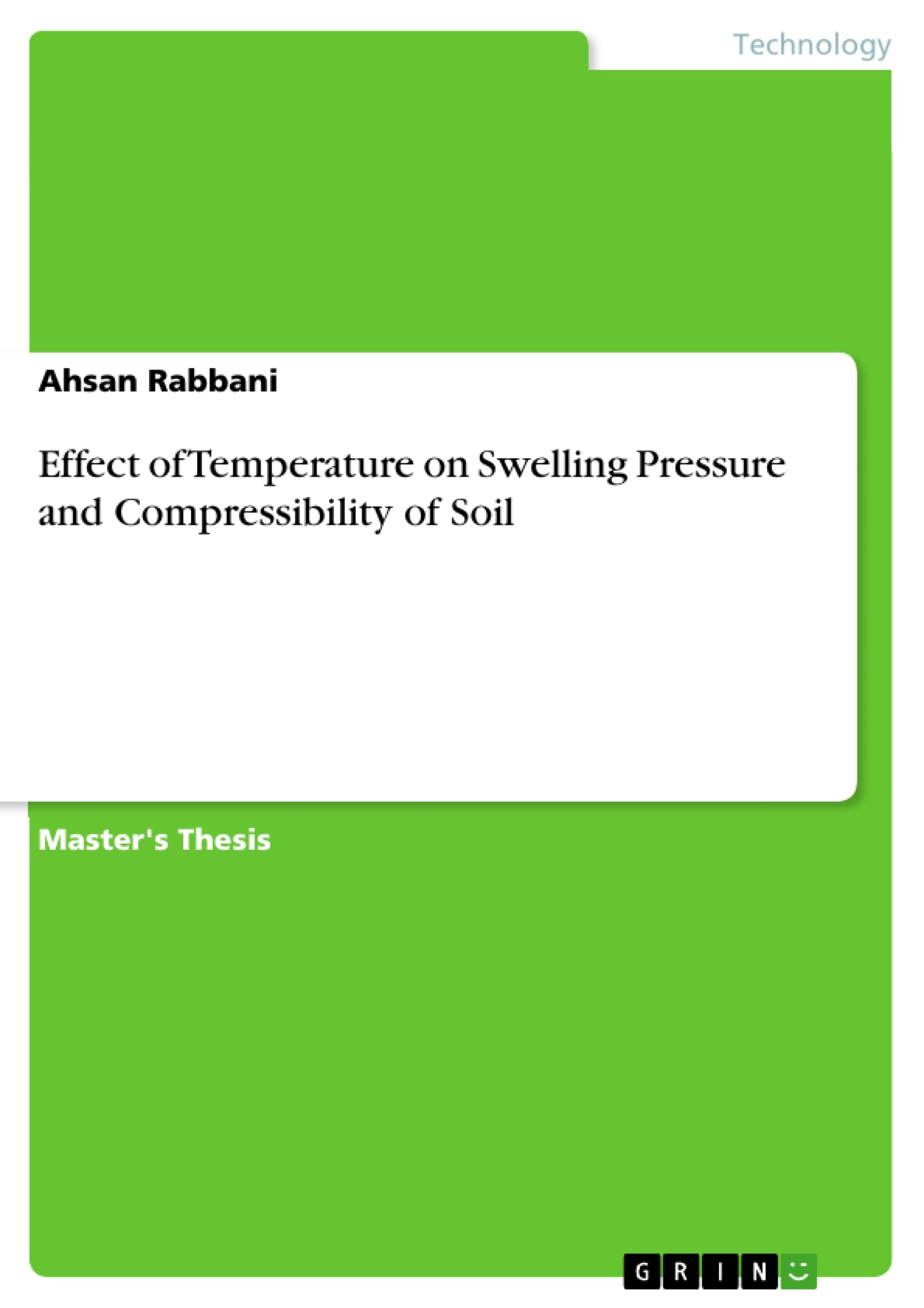Construction of building on clay soil is highly risky due to its poor strength. Clayey soil creates many problems to the Geotechnical Engineers primarily because of repeated change of moisture content. Normally, these soils increase in size and swell when they absorb water and reduce in size and shrink when they become dry. Volume change in soil leads to distortions in the form of settlement due to contraction as a result of dryness or in the form of expansion due to swelling as a result of the absorption of water. There may be the need for soil treatment to improve the engineering properties of such soil. Compacted bentonite is often used as a buffer materials and for radioactive waste disposal system. A good understanding of the hydro-mechanical behavior of clay soil is essential to ensure safe disposal.
The present study reports the results on the effects of temperature on swelling pressure and compressibility characteristics of soil. In this study, two different type of soils were used. One of them was a bentonite (liquid limit = 139%) procured from Bikaner, Rajasthan another one was Rourkela local soil (liquid limit = 35%). A new oedometer was designed and developed in-house to carry out consolidation and swelling pressure tests at a higher temperature. Swelling pressures tests on compacted bentonite specimens of targeted dry density of 1.6 Mg/m3 were conducted under constant volume condition for the temperature range between 25 to 90 0C. Compressibility tests at various temperatures for both soils were conducted using distilled water as the saturating fluid.
It observed that high temperature caused an increase in swelling pressure and compressibility index of bentonite soil. There is no effect of temperature on compressibility index of Rourkela local soil.
Inhaltsverzeichnis (Table of Contents)
- Introduction
- Background and motivation
- Objective of the work
- Book Overview
- Literature Review
- Introduction
- Identification of expansive soil
- Structure of clay mineral
- Kaolinite
- Illite
- Montmorillonite
- Structure of compacted bentonite
- Forces and charges in clay system
- Particle association in Clay
- Swelling Mechanism in Clay
- Swelling pressure
- Swelling pressure testing in Laboratory
- Swelling pressure measurement devices
- Compressibility behavior of bentonite
- Effect of higher temperature on swelling and compressibility
- Material and Methods
- Properties of Soil studied
- XRD Analysis
- SEM Analysis
- Modified oedometer
- Swelling Pressure Test
- Experimental setup
- Constant volume swelling pressure test
- Consolidation Test
- Experimental setup
- Methodology to Measure Compressibility
- Properties of Soil studied
- Result and Discussion
- Swelling Pressure Test Result
- Compressibility Test Result
- Conclusions and Scope for Further Study
- Conclusions
- Scope for Further Study
Zielsetzung und Themenschwerpunkte (Objectives and Key Themes)
The primary objective of this work is to investigate the impact of elevated temperatures on the swelling pressure and compressibility of compacted bentonite, a critical material for waste disposal repositories. The study utilizes a modified oedometer to conduct experiments at various temperatures. This research aims to provide valuable insights for the long-term safety assessment of waste repositories, particularly in relation to the behavior of bentonite under thermal, hydraulic, and mechanical loads.
- Effect of temperature on the swelling pressure of compacted bentonite
- Compressibility behavior of bentonite under varying temperatures
- Development and application of a modified oedometer for high-temperature testing
- Significance of swelling pressure and compressibility for waste repository design
- Importance of understanding the long-term behavior of bentonite buffers in waste repositories
Zusammenfassung der Kapitel (Chapter Summaries)
Chapter 1: Introduction
This chapter introduces the concept of expansive soils and their implications for engineering projects, particularly in the context of foundation stability. The chapter highlights the significance of compacted bentonite as a barrier and backfilling material in nuclear waste repositories. It discusses the need to understand the long-term behavior of bentonite under thermal, hydraulic, and mechanical loading, particularly the impact of temperature changes on its swelling pressure and compressibility.
Chapter 2: Literature Review
This chapter provides a comprehensive overview of existing research related to the behavior of clay minerals, with a particular focus on bentonite. It explores the structure of different clay minerals, the forces and charges involved in their interaction, and the mechanisms responsible for swelling in clay systems. The chapter also reviews previous studies on the swelling pressure of bentonite and its compressibility behavior, particularly under elevated temperatures.
Chapter 3: Material and Methods
This chapter describes the materials used in the study, including the characterization of the bentonite and soil samples. It details the design and construction of the modified oedometer used for swelling pressure and consolidation testing at elevated temperatures. The chapter also outlines the experimental procedures for both the swelling pressure and consolidation tests.
Chapter 4: Result and Discussion
This chapter presents the results of the experimental investigations conducted on the swelling pressure and compressibility of the compacted bentonite at various temperatures. It analyzes the trends observed in the data and discusses the implications of these findings for understanding the behavior of bentonite under different thermal conditions. The chapter explores the relationship between temperature, swelling pressure, and compressibility, highlighting the key factors influencing these parameters.
Schlüsselwörter (Keywords)
This study focuses on the impact of temperature on the swelling pressure and compressibility of compacted bentonite, a crucial material used in nuclear waste repositories. Key research themes include: expansive soils, swelling pressure, compressibility, bentonite, nuclear waste disposal, repository design, thermal loading, hydraulic loading, mechanical loading, long-term behavior, safety assessment, oedometer testing, and high-temperature experimentation. The findings of this study contribute to a deeper understanding of the behavior of compacted bentonite in repository environments and inform the development of more effective and safe waste disposal strategies.
- Citation du texte
- Ahsan Rabbani (Auteur), 2018, Effect of Temperature on Swelling Pressure and Compressibility of Soil, Munich, GRIN Verlag, https://www.grin.com/document/425569



